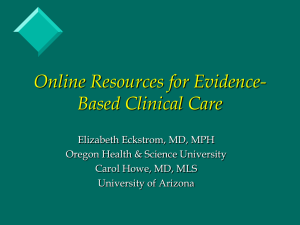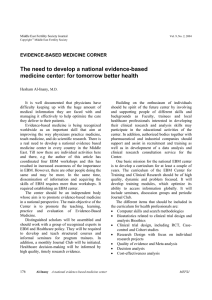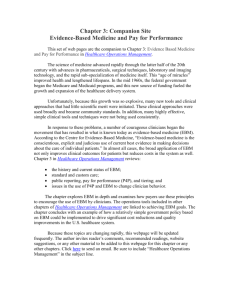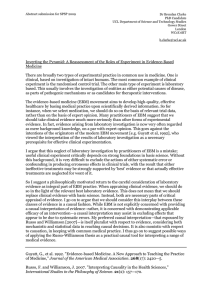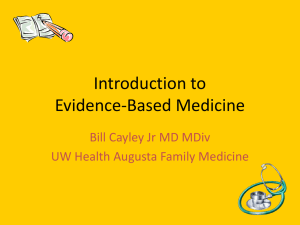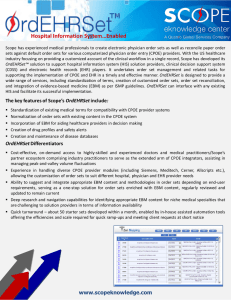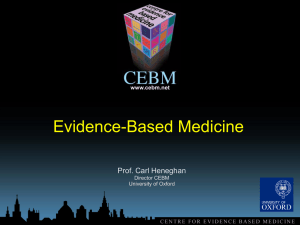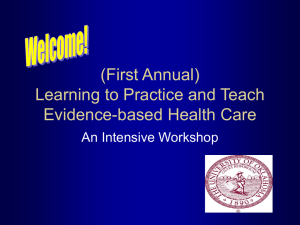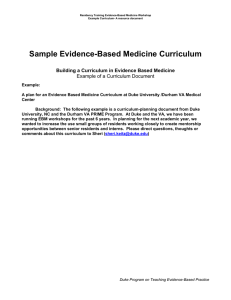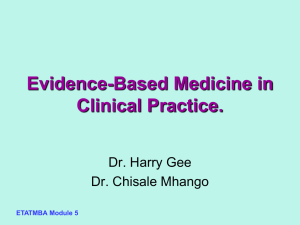Statistical knowledge and clinical knowledge
advertisement
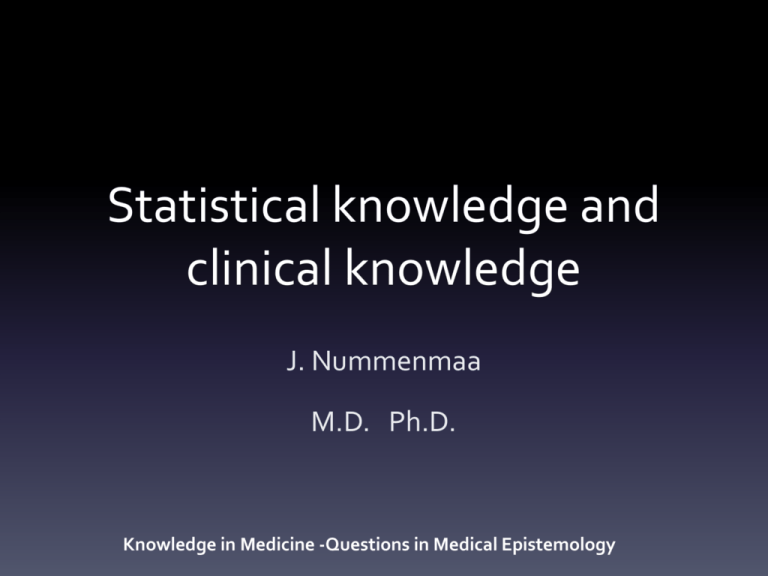
Statistical knowledge and clinical knowledge J. Nummenmaa M.D. Ph.D. Knowledge in Medicine -Questions in Medical Epistemology Evidence-Based Medicine (EBM) • Ensure availability of reliable research results for clinicians – – – – – – How effective treatment? Research done on patients Golden standard = Randomised trial Critical evaluation on research & results Quality improvement Decreasing variation • EBM Guidelines – Bringing evidence to practice What is good evidence? Level A: Consistent Randomised Controlled Clinical Trial, cohort study, all or none (see note below), clinical decision rule validated in different populations. Level B: Consistent Retrospective Cohort, Exploratory Cohort, Ecological Study, Outcomes Research, casecontrol study; or extrapolations from level A studies. Level C: Case-series study or extrapolations from level B studies. Level D: Expert opinion without explicit critical appraisal, or based on physiology, bench research or first principles. Randomised trial • Dr. James Lind 1747 – 4 Scurvy prevention Randomised trial IS TREATMENT X MORE EFFECTIVE THAN •WHOSE •PREVENTION CHOICE? TREATMENT? DIAGNOSIS ASOR CLASSIFICATION •REPRESENTATIVE PATIENTS? Y IN THE TREATMENT OF DISEASE Z? •INDUSTRY? •OBJECTIVES? ONE DIAGNOSIS DOES NOT EXCLUDE ANOTHER •RANDOMISATION ADHERENCE •WHO ELSE, UNIVERSITY? •DO ALL PATIENTS SHARE SAME OBJECTIVES DIFFERENT DIAGNOSES ARE BASED ON •BLINDING •WHY? •COMPOSITE DIFFERENTINDICATORS CRITERIA •CO-MORBIDITY •FINANCIAL INTERESTS? N•APPLICABILITY PATIENTS WITH Z INDIVIDUAL PATIENTS? DIAGNOSTIC DIFFERENCES ON •OTHER FACTORS, LIFE-STYLE ETC •SCIENTIFIC INTERESTS? IN HOSPITALS AND PRIMARY CARE •SIDE-EFFECTS SELECTION OF •COMPARING DIFFERENT TREATMENTS INTERNATIONAL END-POINTS •MEDICATION PREVALENCE AND INCIDENCE HALF TREATED HALF TREATED WITH Y WITH •SURGERY XIN HOSPITALS AND PRIMARY CARE •(PSYCHO)THERAPY HOW TO CHOOSE PROBLEMS ON SOME •CHOOSING ONE TREATMENT = NOT CHOOSING WHAT PATIENT OTHER TREATMENT TREATMENTS ARE SELECTION PROBLEMS OF COMPARED? NUMBER OF END –POINTS IN DIFFERENT GROUPS DIAGNOSTIC CRITERIA Significance of the data Statistical significance: p=0.036 • Risk reduction 30.3% Out of one hundred patients: -> 97 remain healthy -> will get sick whether treated or not -> one incidence can be preventedp-value Statistical significance: -> ARR 1% -> NNT= 100 – Propability to get achieved results if null-hypothesis is true Clinical significance: Relative risk reduction :percentage Absolute risk reduction (ARR%) Number needed to treat (NNT) Clinical importance Treating individual patients Clinically significant risk? • Cholesterol-lowering medication should be started if a person, even otherwise healthy, has a propability of cardiac death higher than 5% / 10 years – Finnish evidence based (Käypä hoito -) guidelines for hyperlipidaemia 7 7 To treat or not to treat? 8 To treat or not to treat? 9 9 What to do with myself? • At the age of 44 • Estimated life-span 88,48 • Intervention: regular exercise + 2-3 doses of alcohol • Benefits: – 0,29 years= 1 600 hours awake – January - March – One hour / day= 16 235 hours – Costs: • Wine 32 500 € • Exercise 500 € p.a. = 22 500 € • Total 55 000 € – One extra hour of life= 10 hours 34€ 10 10 Evidence-Based or Value-Based? • Comparison of hypertension control between different countries: 17,5 - 86,4% • Fahey & Peters: What constitutes controlled hypertension? Patient based comparison of hypertension guidelines, BMJ, 1996, 313, 7049, 93-96 Recommendations based on same evidence: 50% / 50% • Raine, R & al. Lancet, 2004, 364, 9432, 429-437 • Selection of literature • Christiaens & al. Scand J Prim Health Care, 2004, 22, 141-145 Evidence-Based or Value-Based? • 76% of Norwegian men in Trondelage have higher risk for cardiac diseases than guidelines recommend – Cholesterol – Blood pressure • How to deal with risks? – Getz & al 2004 12 Evidence-Based – really? • • • • Is data really reliable? Are the results applicable in practice? Are the results politically acceptable? How do the results relate to functioning of the working group? • Moreira T (2004): Diversity in clinical guidelines: The role of repertoires of evaluation. Soc Sci Med 60:1975-1985. • Value-Based recommendations: – – – – 13 Selection of literature? Valuation of research methodology? How effective treatment is effective? What treatments are favored (Drugs, surgery, therapy)? 13 Hume and EBM Guidelines • ”…when all of a sudden I am surprised to find, that instead of the usual copulations of propositions, is, and is not, I meet with no proposition that is not connected with an ought, or an ought not. This change is imperceptible; but is however, of the last consequence.” – David Hume: A treatise of human nature (1739) 14 14 General Practitioner • Treating human beings not diseases • Contextuality. • Networking • Place of treatment: Clinic, home • Understanding meanings • Resource control •Continuity •Openness •Tolerance and ability to deal with uncertainty •Clinical encounter •Social medicine •Unselected population •Patients present with symptoms EBM vs GP • GP • EBM – Diagnosis – Randomised trial – Interpretation statistical – Patient, symptom – Individual interpretation – subjetive – Uncertainty – ”Objective” • Limited data – Uncertainty: • Lack of knowledge • Statistical significance • Clinical significance • Applying knowledge • Ethics & values • Limited time Clinically relevant research? • University? • Evidence-Based Guidelines? – Does not produce new data – Valuation of research results favours medical treatment • Drug industry? 17 • GPs themselves? How does a GP use EBM Guidelines • Source of information, as a textbook • Searching answers for a specific question • As an institutional quality improvement tool – Grimshaw ja Eccles in Ridsdale L. (Ed.): Evidence-based practice in primary care (Churchill Livingstone).
